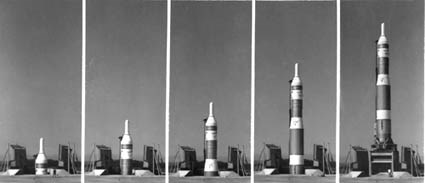Part of a series of articles titled Minuteman Missiles and the Nuclear Arms Race.
Previous: First Generation ICBMs: Atlas and Titan
Next: Weapon System "Q"
Article

This frugal economic climate changed dramatically after Sputnik. In October 1957, when the Soviet Union announced it had used a liquid-fueled ICBM to launch Sputnik into orbit, American scientists and politicians feared a significant "missile gap." Within months, journalists and intelligence analysts began asserting that the Soviet missile force could outnumber the American arsenal by as much as 16 to one by 1960. America's growing sense of insecurity was not lost on Soviet officials, who gleefully announced that their factories were turning out missiles "like sausages." Facing severe criticism for allowing the United States to fall behind in the arms race, the Eisenhower administration poured more money into its missile programs - increasing the Nation's annual space research and development budget by more than twenty-fold within six months after Sputnik. The administration also highlighted the development of the Atlas and Titan missiles. One government spokesperson noted that America's missile program was being carefully designed, first to "attain perfection," and then to "develop the ability to produce in volume once that perfection is achieved."
But America's first-generation ICBMs were neither perfect nor mass-producible. A few weeks after Sputnik, the Wall Street Journal observed that the weaknesses of America's ICBMs "are so profound that ... generals are sure [the missiles] will be discarded altogether after the first half-dozen years." Atlas and Titan were extraordinarily complex, handcrafted machines, containing as many as 300,000 parts, each of which had to be maintained in perfect operating condition. The liquid propellants that powered the missiles' engines were volatile and corrosive, and could not be placed in the fuel tanks until immediately before launch. In addition, the missile crews needed as much as two hours to fuel the missiles. Consequently, instead of being "stable weapons in a state of permanent readiness," these ICBMs required "the desperate and constant attention accorded a man receiving artificial respiration." The missiles were not a "push button affair but will require a highly-trained crew . . . several times as large as the largest bombing crew." Many of these problems could be solved, the Wall Street Journal suggested, by developing a simplified "second generation" of missiles powered by solid-fuel rocket engines.
"A lot of work had been done on solids prior to the initiation of the ICBM program in 1954," recalled General Schriever in a 1973 interview, "but there were a number of things that ruled against using solids at that time." Solid propellants in the mid-1950s could not provide enough power to hurl a thermonuclear warhead across an ocean. Also, solids were difficult to manufacture. They were hard to ignite, and there was no way to control their combustion or direct their thrust after ignition. Given these constraints, the Air Force believed that liquid-fueled missiles were "the only immediate way to go ahead." But the Air Force did not entirely abandon the concept of a solid-fuel missile. In 1956, Schriever reluctantly approved a low-level research program "aimed toward the evolution of a high-thrust ... solid-fuel rocket." Schriever selected Colonel Edward Hall, Chief of Propulsion Development for the Western Development Division, to head the program. According to historian Robert Perry, Hall was a "near-fanatic" about the potential of solid-fuel missiles.
Part of a series of articles titled Minuteman Missiles and the Nuclear Arms Race.
Previous: First Generation ICBMs: Atlas and Titan
Next: Weapon System "Q"
Last updated: October 20, 2020